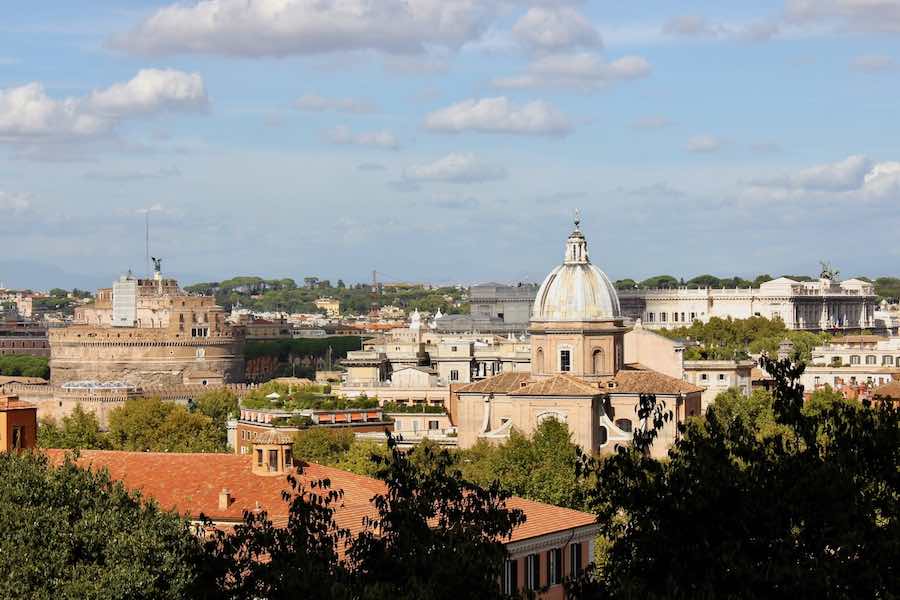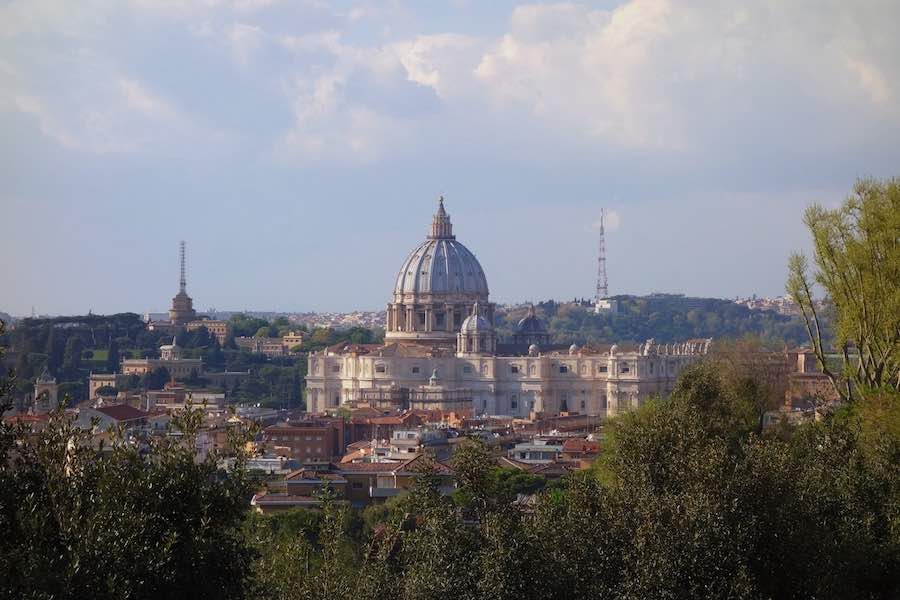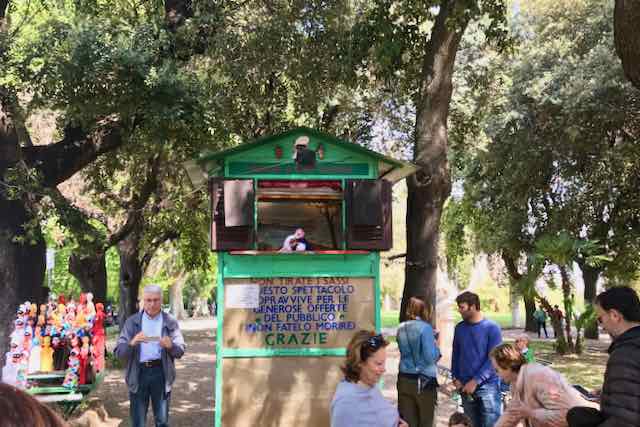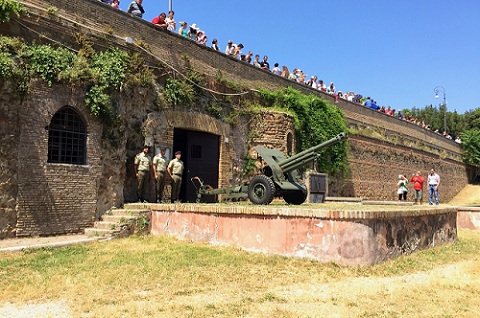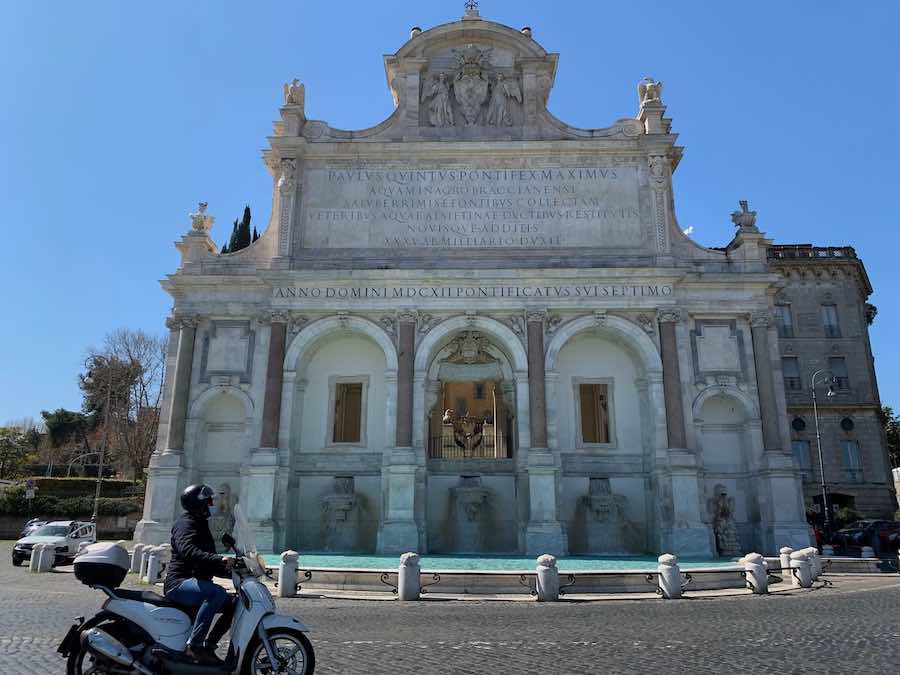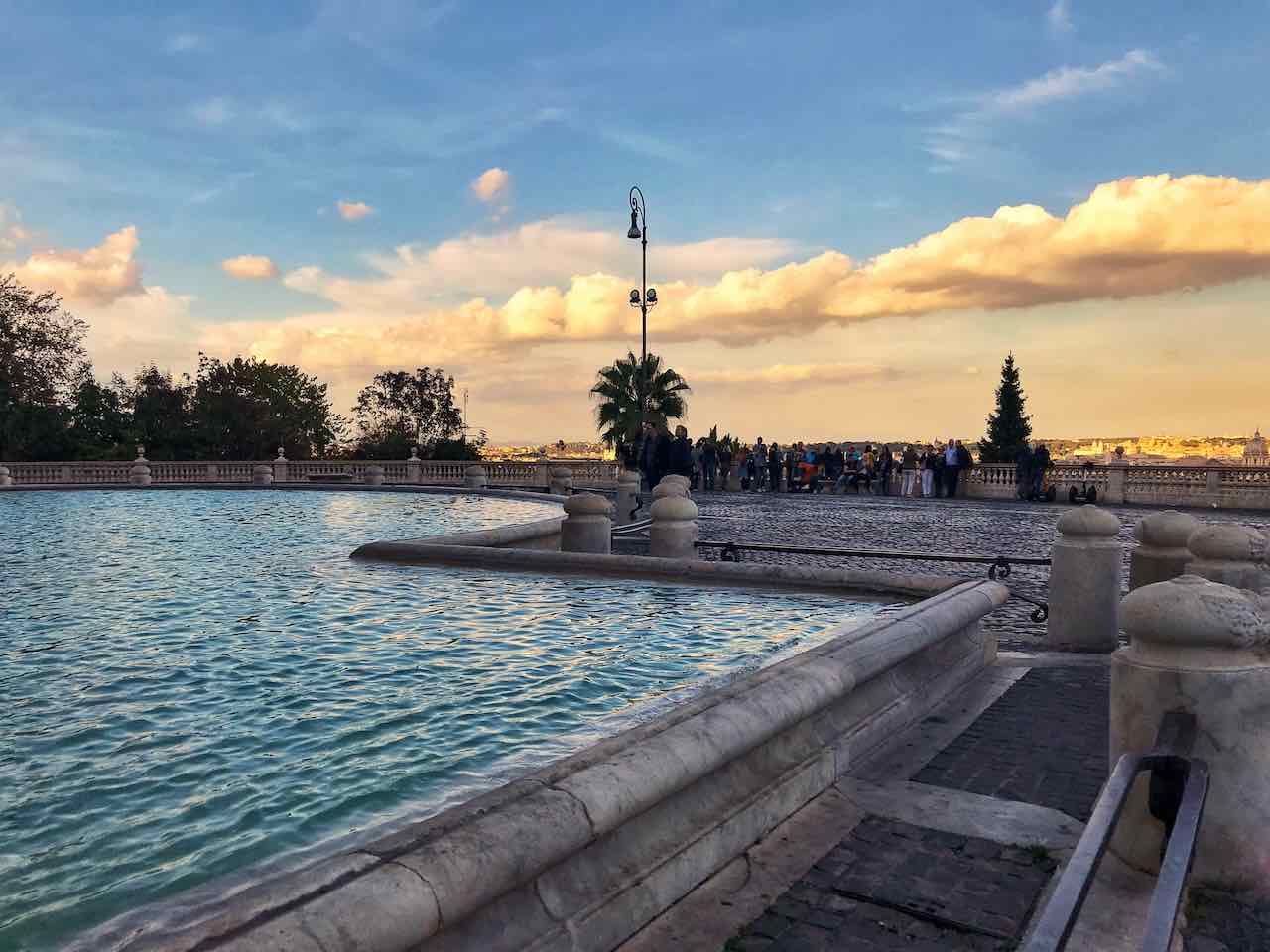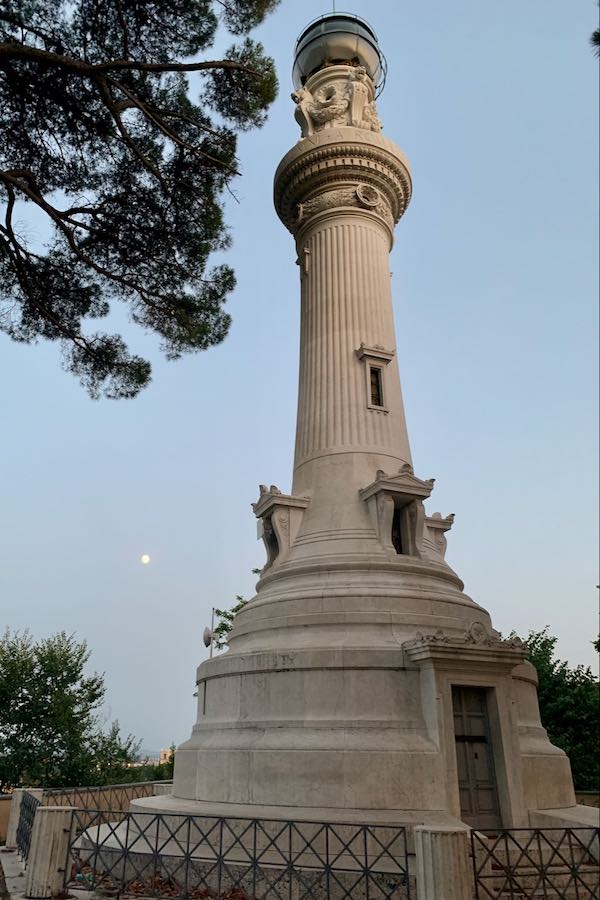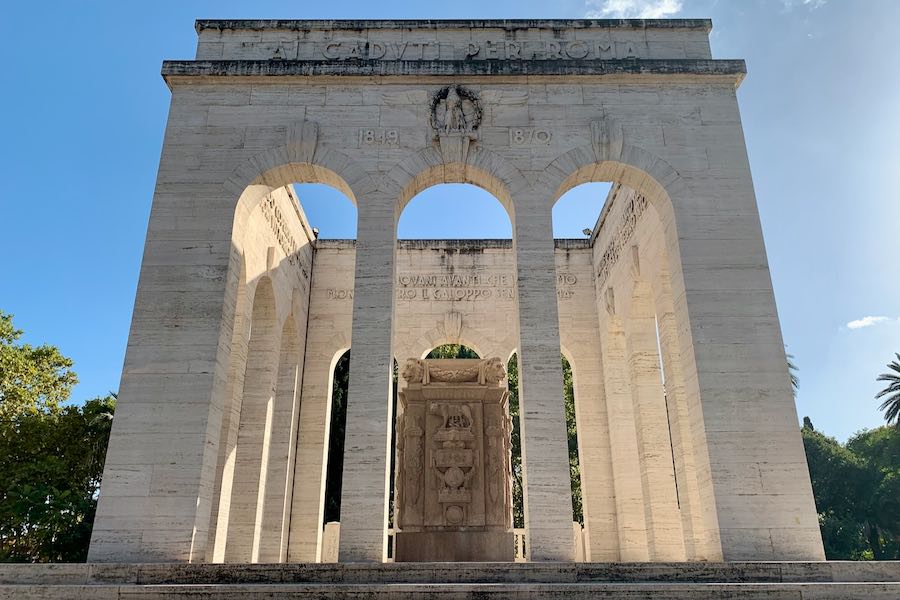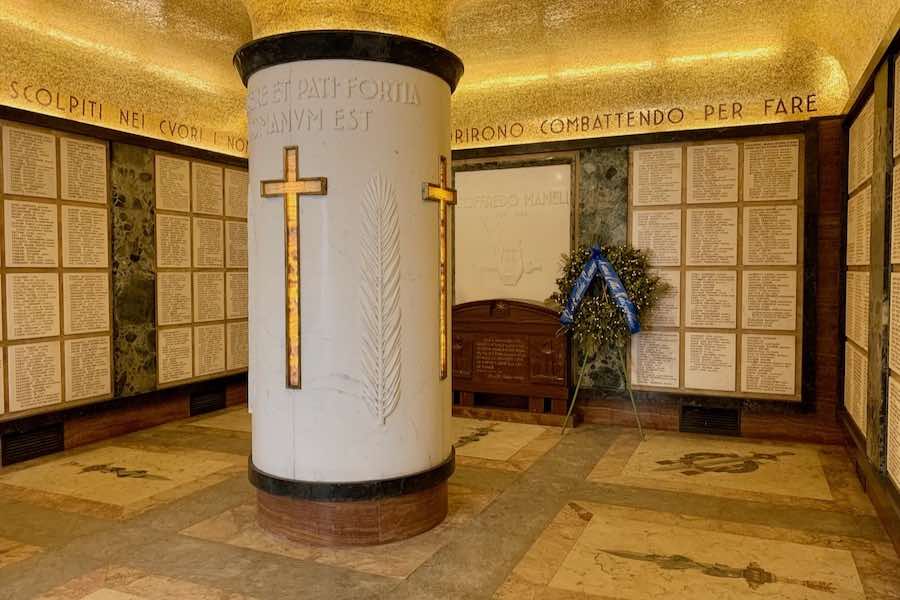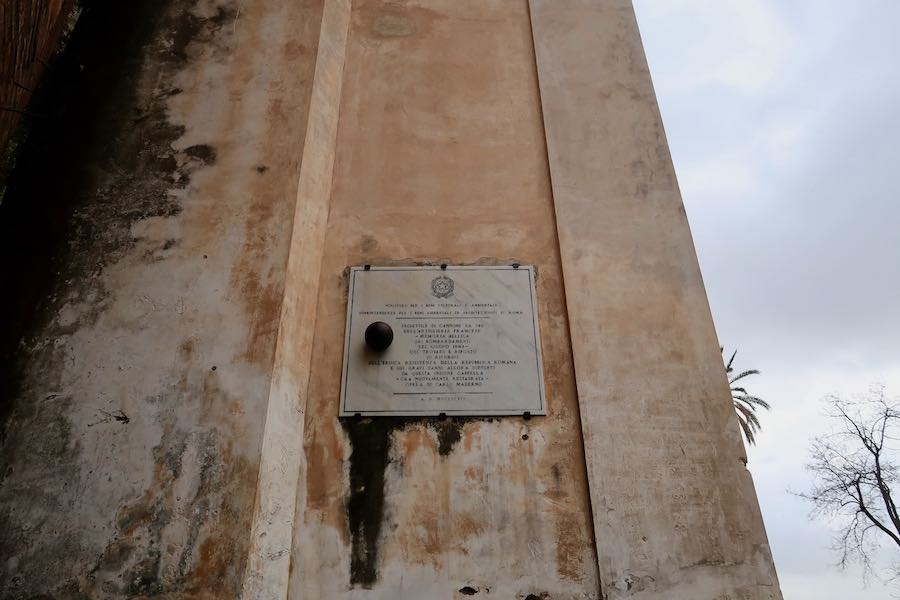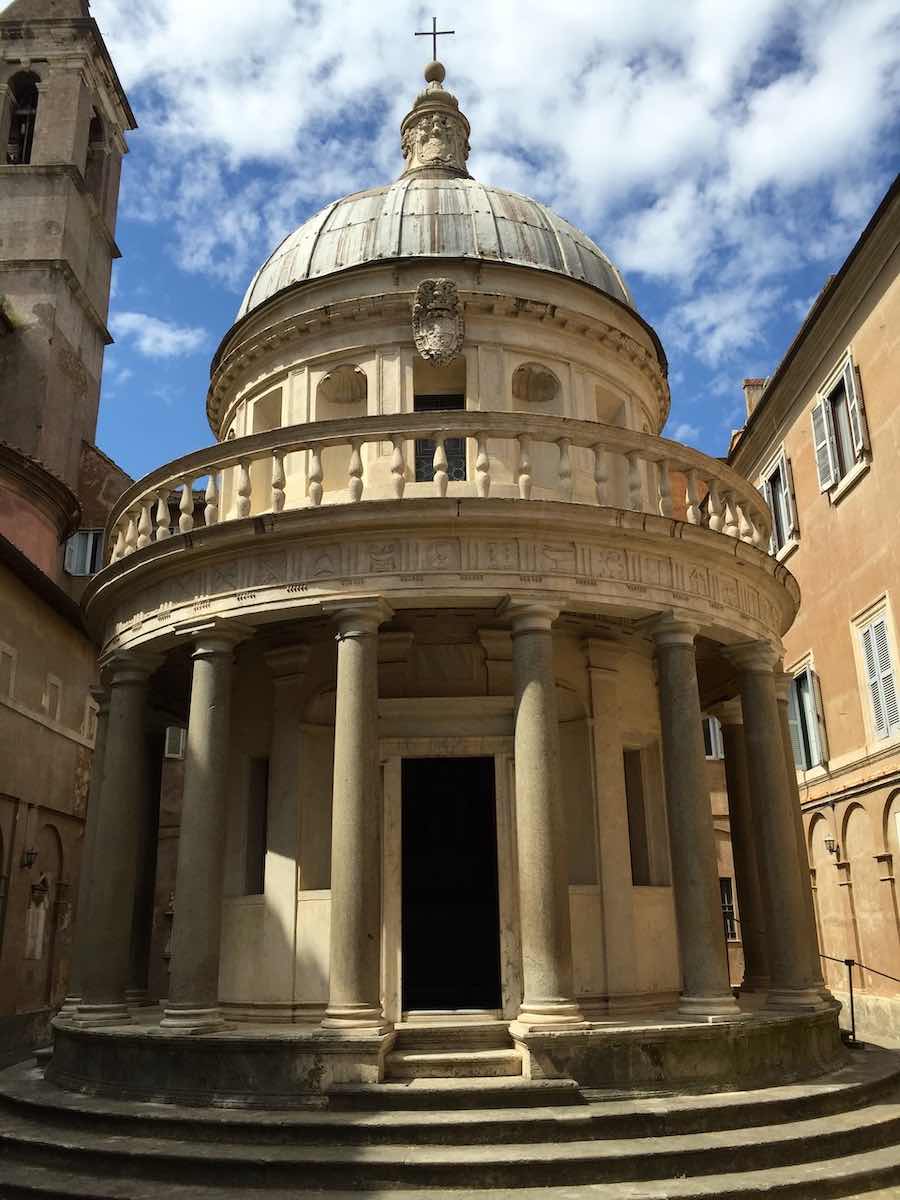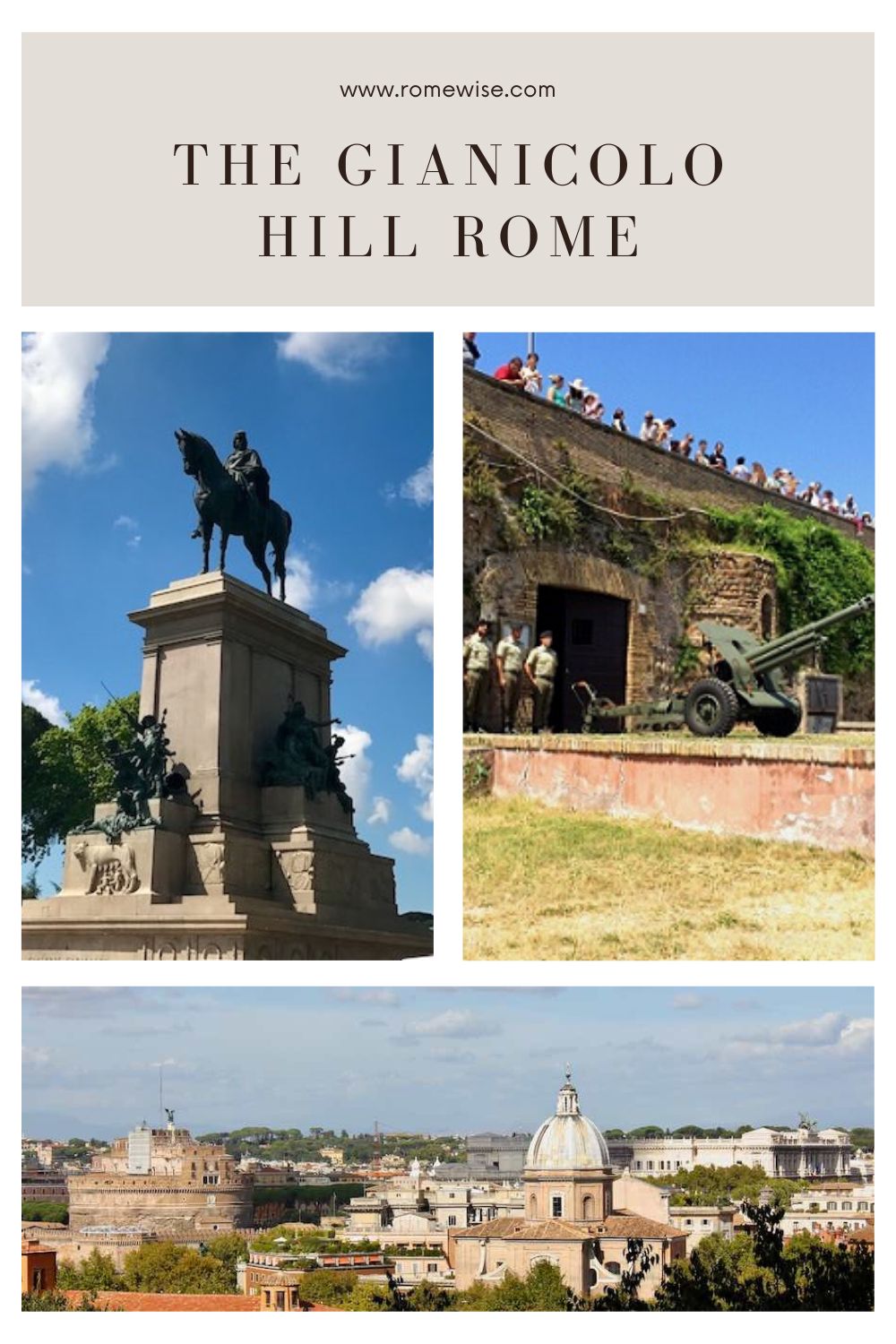- Sign up & get a FREE ebook Subscribe NOW!
- Romewise Home Page
- What to Do in Rome
- Romantic Things to Do in Rome
- Gianicolo Hill
Gianicolo Hill - Everything you need to know
The Gianicolo Hill (Janiculum) is one of the best places to get a panoramic vista of Rome.
You see almost the entire city spread out like a postcard in front of you and to the back, you get bonus views of St Peter's dome.
If you're wondering if it's worth visiting the Gianicolo Hill, read on to find out why it's so special and what you can see and do.
Gianicolo Hill - Views, history, and much more
The green, shady and peaceful Janiculum Hill is where the locals go to escape the summer heat, close to the quiet back streets of Trastevere.
This area of Rome has also been the location for many of the Eternal City's important historic moments, both in ancient times and also in Italy's recent history.
On this page we'll cover:
- History of Gianicolo hill
- Why the Gianicolo is a favorite with Romans
- Why you should bring your kids to the Gianicolo hill
- Things to see on the Janiculum hill
- How to get to the Gianicolo hill
The Janiculum is not one of the Seven Hills of Rome, as it is west of the Tiber and outside the confines of the ancient city of Rome.
History of Gianicolo hill - From ancient Rome to Italy's Risorgimento
Origins, myths, and cults
The Gianicolo (in Latin Mons Janiculum) was the site of some of the earliest settlements of the area, dating back even further than those on the Palatine Hill, one of the original seven hills of Rome.
The name "Janiculum" is connected to the cult of Janus, one of the oldest and most important divinities for Latin, Italic, and Roman religions.
Janus is the god of beginnings and consistently pictured as having two faces.
The Janiculum hill and ancient Rome
The Gianicolo is the second highest hill in Rome (about 90m/295ft) after nearby Monte Mario.
This made it an ideal defensive point for all of the occupants of the Eternal City, dating back to the first settlers in this area, including the Phoenicians, Veii and Etruscans.
In the 7th century BCE, troops of Roman king Ancus Marcius defeated Rome’s rivals and fortified the part of the hill facing the west side of the Tiber and the Aventine hill, cementing its importance for future generations.
When the first emperor of Rome, Augustus, included the hill in the fortification of the city, he named it Arce Capitolina.
Not to be confused with the Capitoline Hill in the city center!
connecting the janiculum hill to the city
To connect this hill to the ancient city, large sums of money were invested in the construction of bridges, roads, and tunnels.
These projects didn't come cheaply.
Consuls, censors, quaestors, and senators funded these works, which meant having their names associated with them.
Both the Cestio and the Fabricio (today Quattro Capi) bridges succeeded their older wooden ancestors.
The bridge Pons Aemilius (today Ponte Rotto) was the first stone bridge built over the Tiber river.
Under Emperor Aurelian, the Janiculum was (partly) included in the defensive walls. These walls originally had three gates: the Settimiana, the Portuense (today Portese), and the massive Porta di S. Pancrazio where the Via Aurelia entered Rome from the Tyrrhenian coast, then crossed the Tiber via the Aemilius bridge.
other uses for the janiculum hill
Due to the hill's elevation, the ancient Roman engineers knew that it could be used to channel water and in the year 2 CE, Augustus built the Alsietino Aqueduct to bring water from the north.
The water was not suitable for drinking and was used mostly for the naumachia (an artificial lake for naval shows) built by Julius Caesar in the Trastevere area.
Between the time of the Roman Republic and the Roman Empire, the Gianicolo took on more new functions, including of burials and Christian martyrdoms.
The Janiculum, during Nero's reign, is said to have been the site of Saint Peter's martyrdom.
No matter what season you visit Rome, here are 4 essential things we recommend never leaving home without:
The Janiculum hill in the Middle Ages
Before the year 1000, Rome was a fortified city confined within the eleven miles of walls raised by emperor Aurelian in the 3rd century.
By the 12th century this grand city was a pale memory: besieged by barbarians, defeated by Goths, deprived of aqueducts, plagued by epidemics, and devastated by earthquakes, Rome had collapsed.
And the same fate also befell its hills, with vestiges of ancient palaces and monuments being suffocated by vegetation.
The population had drastically declined.
The Gianicolo hill became an inhospitable and unsafe place to be.
The Janiculum hill and the Renaissance
In the early 1500s Rome became a very important place for art and architecture.
Many new buildings and monuments were built during this time, including churches, villas, and mansions.
And the Janiculum was no exception.
Click here to jump to the section below about all the things to see and do on the Gianicolo hill.
The Gianicolo hill and the Risorgimento in Rome
The word Risorgimento refers to the historical movement of people rising up against foreign oppression in Italy.
It started in the 13th century with the French invasion of Southern Italy and eventually led to the establishment of the Kingdom of Italy in 1861.
However, Rome was not part of this kingdom until 1870, because it was still under the control of the Pope.
In 1849, people in Rome rose up and formed a short-lived Second Roman Republic, but it didn't last long.
Pope Pius IX called his ally Napoleon Bonaparte III to his aid, and the French king attacked Rome with his powerful army.
Meanwhile, the patriot Giuseppe Garibaldi arrived with about 5,000 volunteers from all over the peninsula in defence of the city.
On June 30, 1849 the last battle in the short history of the Roman Republic was fought on the Janiculum hill, marking the turning point of the heroic defence for the freedom of Rome.
The battleground was the site of an epic slaughter, with a very high death toll among the ranks of both the Roman insurgents and the French troops, but the Romans came out the winners.
Why the Gianicolo is a favorite with Romans
Romans sometimes refer to the Gianicolo as the eighth hill of Rome.
It's tough to find a Roman who doesn't love it!
The views
Looming high above the Eternal City across the Tiber, this spot offers sweeping views that make it a favorite spot for hanging out, enjoying a romantic moment, or just taking in the landscape below at one of the many scenic overlooks.
I've enjoyed many a sunset from high up on the Gianicolo hill!
Keeping cool in the summer
It can get steamy hot in Rome in summer, and the Janiculum hill offers a sense of respite - perhaps because of all the leafy green trees, the cooler breeze or perhaps because of the food trucks selling cold drinks and gelato.
Visit the Gianicolo on a summer evening, and you'll find Romans of all ages strolling along the passeggiata del gianicolo, sitting on the wall chatting with each other, and milling about as the sunset fades and the night air settles in.
Ready to plan your trip?
Book your train
Planning to travel between cities in Italy and other parts of Europe?
Use Trainline to see all the different options available across the different rail companies.
Find your hotel
Find your perfect place to stay in Rome.
Use Booking.com to choose between hotels, guesthouses, and self-catering apartments in neighborhoods throughout the Eternal City.
Buy your TurboPass
Purchase the convenient Turbopass and visit all of Rome's top attractions including the Colosseum, Pantheon, and Vatican.
With one handy pass, it's all included.
Why you should bring your kids to the Gianicolo hill
This spot is a favorite with Romans, not just for enjoying Roman life and beautiful views.
It's chock-a-block with things to do with kids, in particular right around the Piazzale Garibaldi.
The puppet show
On weekends you can enjoy an old-fashioned puppet show, Punch and Judy style, close to the Garibaldi monument.
The performance is always in Italian, but the body language and sounds make it very easy to follow.
The cannon
Every day at noon, just below the statue of Giuseppe Garibaldi, you can witness (and hear) a cannon being fired.
It’s a tradition that dates back to 1847 when it was used to mark the beginning of a new day for workers in the city.
The arcade
There is an indoor arcade just off the piazza that's fun for children.
The pony rides
Another activity perfect for small children is to ride the gentle ponies around the piazza and surrounding streets.
You will find them near the arcade.
For more about these activities, visit our dedicated page about visiting Rome with Kids.
Things to see on the Gianicolo
Piazzale Giuseppe Garibaldi and Garibaldi monument
Piazzale Garibaldi is where the buses stop.
It's the main photo and lookout point for seeing those views of Rome.
Don't miss the view of St Peter's Basilica to the back!
The equestrian monument to Giuseppe Garibaldi honors this important figure in Italian history.
The Walk of Remembrance
In 1883 the Italian State acquired the entire Gianicolo hill from the Papal State, creating a road flanked by marble busts (honoring the heroes of the Risorgimento) known as the Janiculum Promenade, or the Passeggiata del Gianicolo.
The walk culminates on top of the hill, at Piazzale Giuseppe Garibaldi.
The Big Fountain
For us Romans it’s always been called Er Fontanone (The Great Fountain), although officially it is known as the Fontana dell'Acqua Paola, and it recalls sweet memories of our past.
During the hot season, the locals choose the Janiculum as one of their favorite places to escape the heat.
On long hot summer nights, the starry sky, reflecting in the water of this fountain, creates a dreamy painting.
But even on cold and rainy days, this romantic corner is able to touch our hearts.
Poets, singers and movie makers have always been inspired by it, and from its water bed the fountain of acqua paola reflects a noble light.
The design by Giovanni Fontana was based on a Roman triumphal arch.
The overall project consists of five large arches flanked by columns, decorated with white and polychrome marbles plundered from the Roman Forum and the Temple of Minerva at the Forum of Nerva.
The columns in red and gray granite came from the old basilica of St Peter.
a Brief history of the big fountain
The Fontana dell'Acqua Paola was built between 1610 and 1612 under Pope Paul V Borghese (from whom it takes its name).
This artefact was built on the final part of a pre-existing aqueduct, which was restored by the pope to supply water to the Trastevere district.
Under Pope Alexander VIII, a large marble basin was added to the monumental façade, in which a grand central niche was erected.
This addition was to remain empty to allow a view of the botanical garden behind it.
Finally, Pope Innocent XII thought to enclose the fountain with a balustrade of columns coupled with solid iron bars, to prevent horses from drinking the water.
The fountain's design inspired in part the design of the Trevi Fountain, and is the largest monumental fountain in Rome.
Want to explore the vibrant neighborhood of Trastevere?
Join an evening gourmet food and wine tour for an unforgettable experience!
The Manfredi Lighthouse - Lighthouse of the Italians immigrants in Argentina
On November 4th we celebrate “National Unity Day and Armed Forces Day”, remembering the end of WWI on the Italian front.
Among the events organized by the city of Rome, if you happen to walk on top of the Janiculum hill, you’ll see a beacon sending out a beam in red, white and green, the colors of the Italian flag.
It comes from a lighthouse - even though the sea is far away!
The lighthouse is 20 meters high and 10 meters in diameter, and is shaped like a ribbed Roman column with a capital.
On top there is an altar with four lions supporting the lantern designed to radiate a very bright light with the colors of the Italian flag.
a Brief History of the manfredi lighthouse
The lighthouse was built in 1911, unveiled on September 19, by Italians who had emigrated to Argentina and who used their own funds.
Argentina at that time was a rich country, committed to welcoming masses of immigrants, coming mainly from Italy.
This association of “The Italians of Argentina” wanted to celebrate the united country and its capital which originally established in Turin (1861 - 1865) and then in Florence (1865 - 1870), was finally established as being Rome after a brief period where it was Turin and then Florence.
Manfredi was the name of the architect in charge of the project.
They also managed other important projects, including supervising the building of the Vittoriano in Piazza Venezia - the stone used on the lighthouse is the same as that used on the Vittoriano.
The Wall of the Constitution
On 17 March 2011, on the 150th anniversary of the Unification of Italy, then President of the Italian Republic, Giorgio Napolitano unveiled the "Wall of the Constitution".
Located on the Belvedere of the passeggiata del Gianicolo, next to the Villa Lante, the wall shows the words of the Constitution of the Roman Republic adopted in 1849.
All sixty-nine articles of the Constitution are engraved on on the wall, measuring 50m/164ft in length.
Janiculum hill ossuary memorial
The unification of the country took place in 1870, with the proclamation of Rome as the capital of Italy the following year.
The remains of the young (and not so young) patriots who had sacrificed their lives to realize their dream of a country based on the principles of freedom and unity, were scattered in different places in the city.
Later in the 1870s an idea was proposed to build a memorial on the Gianicolo hill, close to where many had fallen in battle and been buried.
But it was only during the 1930s that the project took shape.
The chosen area was right on the spot (Colle dei Pini), where the most crucial battle took place.
When you visit, you will see the monument is decorated with allegorical figures inspired by Roman antiquity, such as the she-wolf, the imperial eagle, shields and short-swords.
On the back of the portico, a double set of stairs descend to the Shrine, with a massive bronze portal.
A low vaulted ceiling is covered with gold mosaic tiles.
Polychrome marbles cover the floor and walls, on which 36 burial niches are arranged, closed by tombstones that recall the names of over 1600 heroes fallen.
One of these tombs is of a 21 year old man, who will be famous forever.
His name was Goffredo Mameli.
We Italians remember it every time we sing the national anthem.
Address: Via Garibaldi, 29, 00153 Rome
Opening Hours: Daily 10:30 AM - 5:30 PM
Goffredo Mameli - Patriot
There is a beautiful tomb dedicated to Goffredo Mameli in Rome's famed Verano Cemetery.
Although he is actually buried here on the Gianicolo, it's worth visiting this monument to him at the Verano, to see all the other fascinating tombs there.
San Pietro in Montorio
Standing on the remains of a decaying Franciscan convent, a new church was funded by the Catholic monarchs, King Ferdinand and Queen Isabella of Spain, as a pillar commemorating the martyrdom of Saint Peter.
Pope Alexander VI Borgia consecrated the church of San Pietro in Montorio in 1500.
While plain-looking on the outside, the interior of this church hosts a collection of masterpieces such as the Flagellation by Sebastiano del Piombo, a Madonna della Lettera fresco by Pomarancio and a Sibyl fresco attributed to Baldassarre Peruzzi.
Two chapels were designed by Giorgio Vasari (who frescoed the ceiling of one of them, depicting himself in a black dress) and one was designed by Gian Lorenzo Bernini.
If you look carefully at one of the outside walls, you will see a cannonball from the Risorgimento placed there.
Hours of access to the church: Daily, 9AM – 12PM, 3PM – 4PM
Address: Piazza di S. Pietro in Montorio
Tempietto del Bramante
In the courtyard of the convent, you can see the Tempietto Del Bramante from the early years of the sixteenth century, universally considered one of the most important structures of High Renaissance architecture.
This work was part of the new architectural project of the Janiculum hill and is a celebratory monument to the birth of Giovanni d'Aragona, eldest son of King Ferdinand and Queen Isabella of Spain.
The plan was entrusted to the famous architect Donato Bramante, who took inspiration from the paleo-Christian circular edifices built where a martyrdom took place; an archetype so congenial to the architect that he used it as the model for the new St. Peters Basilica, commissioned by Pope Julius II della Rovere.
Hours of access: Tuesday to Sunday 10AM - 6PM. Closed Monday
Information: https://www.accademiaspagna.org
The perfect 3-day itinerary in Rome
Trying to figure out how to organize your visit to Rome? I've got the perfect 3-day itinerary for first-time visitors (or those who have not been here in a while.) It works for a 2.5 day visit as well.
In my 3-day itinerary, you'll see all the major must-see Rome attractions like the Vatican, Colosseum, Trevi Fountain, Pantheon, Piazza Navona, Spanish Steps, and much more.
And if you have more time, or want suggestions for extra/other things to do, you'll find that there too.
Visit my page with the best 3-day itinerary in Rome for first-timers.
Villa Lante al Gianicolo
Villa Lante al Gianicolo is one of the best-preserved Roman villas of the 16th century.
It is a testimony to the endeavor of the Raphael school and of the so-called 'new golden age' of the Medici popes.
It was built on the foundations of an ancient Roman building and designed as a summer retreat to escape the heat of the city.
The owner was Baldassarre Turini da Pescia, a rich and powerful cardinal who was the personal secretary of both popes Leo X and Clement VII (both Medici.)
The architecture is attributed to Giulio Romano, Raphael’s favorite pupil as well as a friend of the cardinal.
As the villa today is the site of the Finnish Academy, you may visit by appointment only.
Address: Passeggiata del Gianicolo, 10
Hours: Open Monday - Friday 9AM - 12PM. Closed Saturday and Sunday.
Website: https://irfrome.org/en/
Email: To book a visit, write to info@irfrome.org.
How to get to the Gianicolo hill
The Gianicolo hill is on the other side of the Tiber River from Rome's historic center.
It rises high between the Vatican and Trastevere (it is actually part of Trastevere.)
The easiest way (besides taking a taxi) to get to the top of Gianicolo hill, Piazza Giuseppe Garibaldi, is to take one of the two buses that stop there, the 115 or the 870.
The best stop to catch one of these buses is in front of the Santo Spirito hospital on the Lungotevere. The stop is called "LGT Sassia/S. Spirito".
If you enjoy a vigorous walk, I love the path up from around this spot.
You can just follow the curving road and enjoy the panorama as it grows and widens below you.
From Piazza Garibaldi, the walk the rest of the way is downhill.
For an extra special trip up the Gianicolo hill, you can book tours where you get chauffeured through the city in a vintage Fiat 500, or in a golf cart (complete with a gelato stop!) as well as more active tours where you get to explore on e-bikes.
Romewise's Top Travel Resources
Ready to book your trip to Rome? Take a look at these helpful links to companies we use and trust:
- Keep your travel spending simple with the Wise card, which removes all the worry about exchange rates and high transaction fees all over the world
- Search for and book your perfect accommodation
- Our complete guide to what to pack for Rome
- The number one travel accessory, a multi-point travel adapter and voltage converter
- Browse a huge range of tours in Rome and beyond
- Experience unique tours and special access to Rome's most popular sights
- Protect yourself with comprehensive travel insurance
Within this post there are some affiliate links for products and services. For more details about our affiliate policy click here.
Get your 100% free Rome trip planner now!
Simply sign-up today for our free newsletter and get the Romewise Quick Start guide to Rome:
We are committed to respecting your data. Click for our Privacy Policy.
Comments? Questions? Suggestions?
Please come over to the private Romewise Facebook group and join in the conversation.
You will often find me there, happy to answer your questions / comments!
You will also meet other Rome lovers and experts, too.
What are you waiting for?
- Romewise Home Page
- What to Do in Rome
- Romantic Things to Do in Rome
- Gianicolo Hill

